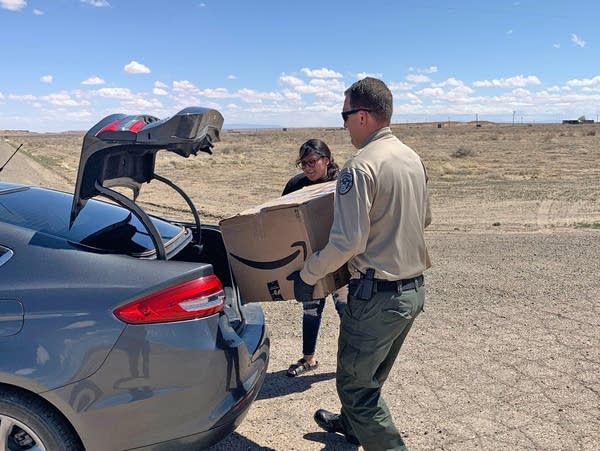On the Navajo Nation, college students navigate a curfew and digital dead zones
The pandemic is making getting through college harder for students on the wrong side of the digital divide. In rural Arizona, when campuses closed, some students couldn’t log on from home, because they had no access to the internet. A local sheriff flew laptops and hotspots to community college students on the Navajo Nation.

When Jessica Austin decided she wanted to become a teacher, she enrolled at the only option in town, Northland Pioneer College. The rural community college has four campuses, but all of them are hours away from where Austin lives in Kayenta, Arizona, population 5,000. Austin attends classes in one of NPC’s five satellite centers run by the college. In normal times, she and a few other other students gather in a room with a screen, and her professors beam in from other locations. When the pandemic hit, everything closed. Austin lost her classroom and access to the computer where she did her homework.
“The first thing that I was worried about was the internet access and having to access all the materials I needed at home from home and then also worrying about my kids doing their classes and getting their learning materials from school,” said Austin, 32. Her children are 8, 13 and 16.
Austin wanted to finish her spring classes so she could graduate in December and go on to earn her teaching license. The pandemic worsened a stubborn digital divide.
Many rural places lack access to broadband. On the Navajo Nation where Austin lives, it’s particularly stark. In 2018, Arizona’s Broadband Strategic Plan reported 95 percent of people living on tribal lands were unserved or underserved.
Nationwide, the FCC documents two-thirds of Americans living in rural or tribal areas lack access to high-speed internet. That’s compared to 2 percent of urban areas.
NPC didn’t want its students to lose momentum during the pandemic. Research shows students who take time off are less likely to finish.
Northland Pioneer College left its wifi turned on, so students could drive to the parking lot and work from their cars, but there was a nightly curfew, and that didn’t leave Austin much time. Navajo health officials were trying to stop the spread of the virus. The pandemic hit early and hard. The infection rate in May was higher than New York’s.

For students like Austin, the sudden migration to online classes wasn’t a simple matter of logging on from home.
“We have broadband initiatives going on right now on the Navajo Nation,” Northland Pioneer President Mark Vest said. “We have rural broadband initiatives underway in our area. And those are good. But they're not finished.”
Northland Pioneer College serves students in Arizona’s two poorest counties. Forty-five percent of its students are Native American. Enrollment fell by 11 percent as students took time off to care for family members or scrambled in the economic downturn.
Northland Pioneer College staff reached out to students to see what they needed to continue.
“I had some students send me photographs of their handwritten assignments by text,” English professor Elizabeth Oliphant said.
“I started hearing, you know, so-and-so doesn't have a laptop,” said Betsy Wilson, who raises scholarship funds for Northland Pioneer College. Wilson rushed online to buy laptops and hotspots. She wondered how she could deliver them to students scattered hours away by car. A colleague reached out to the Navajo County Sheriff David Clouse to ask if anyone was headed toward Kayenta, an early hotspot for the virus.
“And I’m like, actually we are. And so we said we'll fly these things up there,” said Clouse, who tucked the box of laptops into his four-seater plane.

Austin got one of the Chromebooks in early April. Her kids relied on it, too.
“We actually have to share,” Austin said. They worked out a schedule for each child to do schoolwork, youngest to oldest. Austin took the laptop in the evenings.
“I'll usually be sitting here at 11, 12 o'clock still working on my classwork,” Austin said. She was able to finish her spring classes and enroll for summer.
The problems with staying connected add yet another barrier for students whose education was already precarious. Many of Northland Pioneer’s students are first-generation college students and low-income. To try to help students who are facing setbacks during the recession, NPC cut its tuition rate in half through spring of 2021. It also reduced the amount of money it collects through property taxes, to try to help the entire community weather the economic downturn.
NPC is using up its modest rainy day fund to make up the gap. “And as I told our board and our board agreed,” Vest said, “it is pouring outside right now metaphorically for everybody in our communities.”

